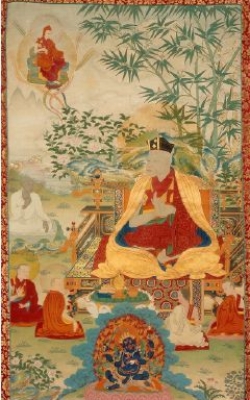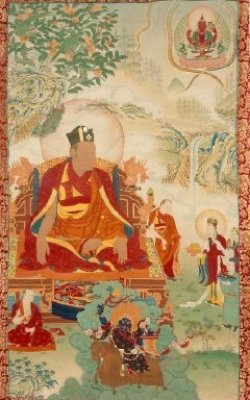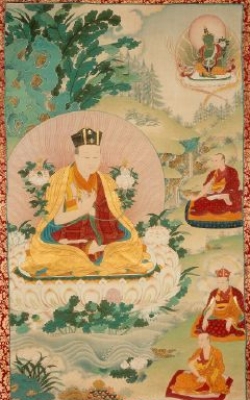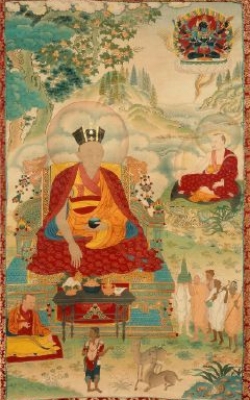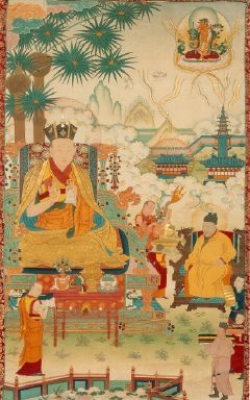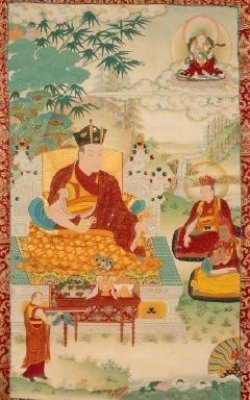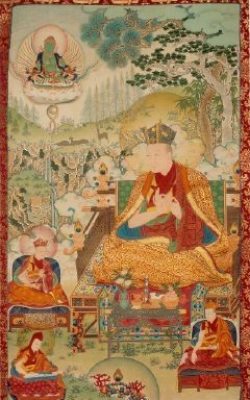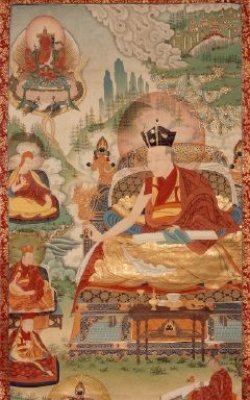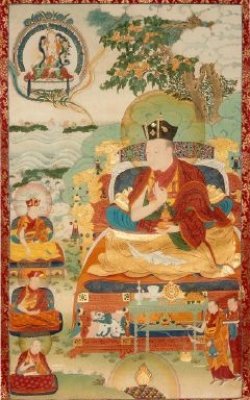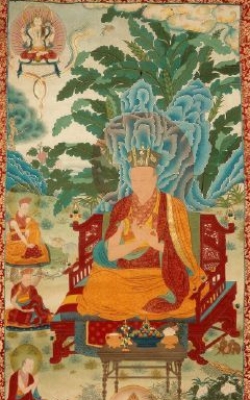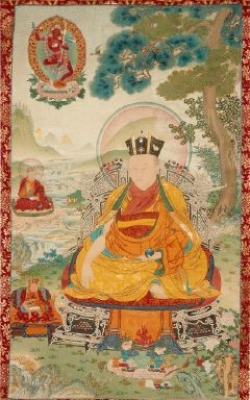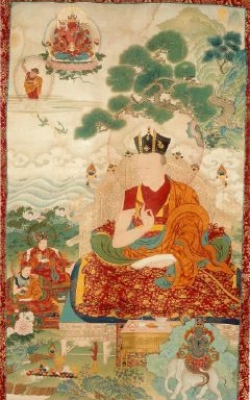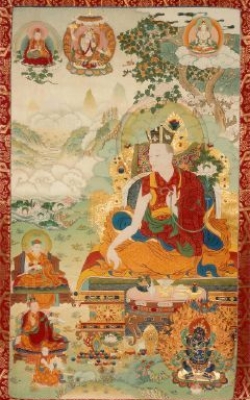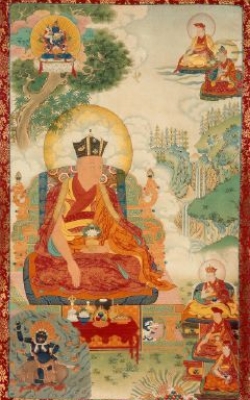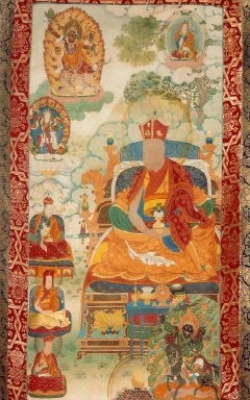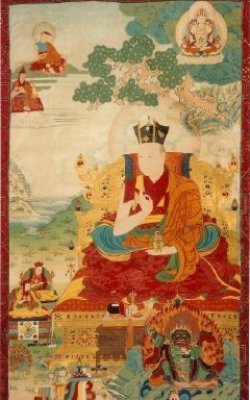Karmapa V - Dezhin Shegpa
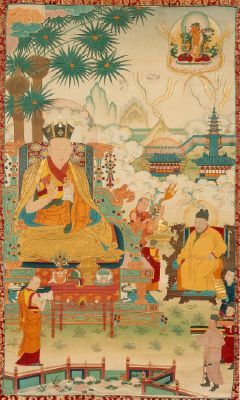
THE Vth KARMAPA
(1384 - 1415)
By showing your major and minor marks,
you instill in us lucid faith.
You are the tathagata who is
guru to the beings of the three realms,
Fulfilling the needs of fortunate ones through supreme siddhi.
Deshin Shekpa, we supplicate at your feet.
Dezhin Shegpa was born at sunrise on the eighteenth day of the sixth month of the year of the Wood Mouse (1384 CE.) to the yogin Guru Rinchen and his wife. Lhamo Kyi. His mother’s pregnancy had been such an auspicious event and immediately after his birth, Dezhin Shegpa was heard to exclaim, "I bow down to all the buddhas. I am Karma Pakshi. Om mani padme hüm."
When he reached the age of five, Dezhin Shegpa was invited to Kongpo Ngakphu, where a great meditator called Shao had slipped on the ice and broken three of his ribs. The young incarnation massaged his ribs and Shao’s injuries healed, causing him no further pain.
During this period Dezhin Shegpa received several empowerments and textual transmissions for later practice. These included the six doctrines of Näropa and the mahamudra of Tilopa, the principal Kagyu instructions. At the age of seven he received novice ordination from the great abbot, Ngakphu Sonam Zangpo, with whom he went on to study the full range of hinayāna and mahåyåna teachings. Then he was formally enthroned at Tsurphu monastery. He continued his education there with his tutor, until being ordained a monk at the age of nineteen in the largest ordination ceremony (eighty monks) ever held in Tibet.
Once his basic education was completed, Dezhin Shegpa began to tour. On his travels he met the Nyingma terton ("finder of hidden texts"), Sangye Lingpa, whom had known in his previous incarnation. The tertön presented him with a scarf and some gold, and Karmapa reminded him that he still possessed the previous Karmapa’s walking stick. Sangye Lingpa was astonished by the power of Dezhin Shegpa’s awareness and became very devoted to him. Traveling on, Karmapa received the empowerment of Vajramälä and other teachings from the saintly meditator, Yeshe Pal.
Subsequently, Dezhin Shegpa was invited to visit Kham. During this tour he was engaged in giving many teachings to both religious and lay people. The instructions he gave varied to suit his audience. covering all aspects of dharma, from basic mahåyäna precepts to the tantric yoga of the Six doctrines, At the conclusion of the visit, Dezhin Shegpa returned to Tsurphu.
The fifth Karmapa concerned himself greatly with the reconciliation of divided communities and attempted to establish nonviolence as the norm of social and political behaviour. He created protected reserves for wild animals, and put an end to toll roads, Thus, his compassion expressed itself in both the social and religious spheres.
An important aspect of Dezhin Shegpa's career was his relationship with the Ming Emperor Yung Lo. The latter, inspired by a dream of Avalokiteshvara and at the prompting of his wife, invited Karmapa to Visit China in 1406 C. E. The letter of invitation "My father and both parents of the queen are now dead. You are my only hope, essence of buddhahood. Please come quickly am sending as offering a large ingot Of silver, one hundred fifty silver coins, twenty rolls of silk, a block or sandalwood, one hundred fifty bricks of tea and ten pounds of incense." on Dezhin Shegpa's arrival in Nanking three years later, he was welcomed by ten thousand monks. At the palace the emperor greeted him with a scarf and a precious shell, the spiral of which turned to the right. The emperor thought that if Karmapa really did have telepathic powers as people claimed. he would know his Wish that he should be given the same gifts in return. As the emperor was thinking this, Dezhin Shegpa pulled a scarf and a conch shell, spiralling to the right, out of his pocket and gave them to Yung Lo.
The emperor feted his new-found guru, giving him the place of honour on his left. As an indication of his devotion he gave Dezhin Shegpa a higher throne than his own. The reception room was full of offerings and food and entertainment were presented in abundance. Throughout the next month. while Karmapa rested after his long journey, the emperor and his court continued to shower him with presents. In this manner an atmosphere of surrender and devotion to the teachings was developed.
Finally. on the fifth day of the second month of the year of the Earth Mouse. Dezhin Shegpa began to teach. For the next two weeks he be.
stowed on the emperor and empress the empowerments of the red Avalokiteshvara. Vajrakilaya, Guhyasamaja, Maitreya, Vajradhätu, Hevajra, Tärä, Vairocana, Bhaisajyaguru and the thousand-armed Avalokiteshvara. During these weeks Dezhin Shegpa revealed the miraculous nature of enlightened energy, awakened by the accomplishment of these vajrayāna teachings.
- On the first day as the emperor made offerings of robes to his guru and the monks, a magical temple seemed to be present in space.
- On the second day a rainbow reminiscent of a begging bowl appeared, followed by cloud formations resembling groups of I
- On the third day the atmosphere was filled with fragrance and a sweet and gentle rain fell,
- On the fourth day a brightly coloured rainbow appeared over Dezhin Shegpa’s house,
- On the fifth day space appeared to be full of auspicious symbols and people were convinced that they could see arhats in the city streets.
- On the sixth day many lights seemed to issue from Dezhin Shegpa's shrine.
- On the seventh day, an unearthly red glow came from the Buddha rüpa on the main temple and illuminated the grounds,
- On the eighth day two lights appeared in space; one hovered over the royal burial ground and one hung over the emperor's palace.
- On the ninth day a crowd of people claimed that they had observed an old monk who flew through the air and then disappeared at the door ol' the temple.
- On the tenth day a crane and a bird like a blue garuda flew together in the sky,
- On the eleventh day luminous rays seemed to stream to the east from Karmapa’s temple and the house in which he was staying.
- On the twelfth day there was a rain or flowers onto the emperor's palace,
- On the thirteenth day people swore that they had seen several monks in the sky, who were saying prayers and making prostrations in the direction Of Karmapa's residence.
- On the fourteenth day the ceremonies were completed. A nock of cranes danced in the sky and clouds appeared in the shape of symbolic deities, garudas, lions, elephants. stupas and dragons.
On the next day the Karmapa was honoured by the emperor, who gave him an honorific Chinese name. On the following day a reception was given for Dezhin Shegpa in the royal palace. To complete the honour a final feast was held in Karmapa's residence During these celebrations the display of Vajrayana energy invoked by Dezhin Shegpa continued,
Emperor Yung Lo decided that the apparently miraculous events which he had witnessed due to his devotion, should be recorded for posterity. He commissioned talented artists to represent them in painting on large rolls of silk, one of which was kept at Tsurphu. The emperor himself composed a literary account of the miracles, which was transcribed onto the paintings in five languages: Tibetan. Chinese, Mongol, Yugor and Turkic,
After the conclusion of the ceremonies and teachings. Dezhin Shegpa set out on a pilgrimage to Wu-tai Shan, the Five Peaks of Manjushri. However. despite this separation from his guru. the emperor continued to experience the direct inspiration of his teaching because of his unshakeable devotion.
When Dezhin Shegpa returned from his pilgrimage he discovered that the emperor was busy with plans for an invasion Of Tibet. Yung LO attempted to rationalise his plans to his guru. saying, "I only want to send a small cavalry army to Tibet, because there are many different sects who might fight among themselves in the future. It would be better if they were all part of your sect. Then every year there could be a Tibetan religious Council meeting in a different part of Tibet.”
Karmapa was not seduced by the emperor's ambitious project and discouraged him by saying, "One sect cannot bring order to the lives of all types of people. It is not beneficial to think of converting all sects into one. Each individual sect is especially constituted to accomplish a particular aspect of good activity, so please do not send your army." Yung Lo was convinced by these words and acquiesced to his guru's wishes.
In fact, Dezhin Shegpa had subsequently to dissuade the emperor second time from an invasion.
This occurred when a Chinese ambassador on a mission in Tibet was attacked and destroyed by bandits near the Drigung monastery. When the emperor was informed of this, he prepared a punitive expedition, but Karmapa was again able to persuade him not to respond with counter-terror. In this manner Karmapa devoted himself to spreading the way of nonviolence and tolerance.
The emperor's relationship with Karmapa was one of deep sincerity and confidence. As a result of his devotion one day during a ceremony, Yung LO perceived the boundless nature of Karmapa’s spirituality symbolised by the black vajra crown. The emperor realised that it was due to his own devotion to the guru that he had been able to see the black vajra crown, which is symbolically present above the heads of all the Karmapa incarnations„ So he decided to have a replica made, ornamented with precious jewels and gold, which he gave to his guru. Deshin Shegpa developed the ceremony in which he displayed this replica to people, while embodying the compassion Of Avalokiteshvara, In this way he communicated the inspiration of his own spirituality. From this time on, the ceremony of the black vajra crown has become an integral feature of the dharma activity of the Karmapas.
In 1408 C'E„ Dezhin Shegpa informed the emperor of his decision to return to Tibet, Yung Lo, who was upset by the news, said, "You are very kind to have come here but your stay has not been long. In former times an emperor was more powerful than his guru, but you, my guru, are more powerful than I am. I cannot prevent you from leaving now that you wish to go, but you must return when I request,"
After a long journey, Dezhin Shegpa finally reached Tsurphu. He discovered that the monastery had been damaged by an earthquake and so he carried out repair work. In addition, he directed the transcription of the Tripitaka in silver and gold. He then distributed wealth and food among the monks and people of central Tibet,
Karmapa was highly venerated by his contemporaries. Je Tsongkhapa sent a letter to Dezhin Shegpa in which he wrote, "You are like a second Buddha. I would like to see you, but I am in a three-year retreat. So, I am sending you a statue of Maitreya which belonged to Atisha."
Despite the enormous responsibility of guiding the Karma Kagyu school, Dezhin Shegpa never wavered from his attitude of gentleness and love. Trung Mase Togden, the founder of the Surmang complex of monasteries, once asked Karmapa to reprove his Karma Garchen people who had broken their commitments. Dezhin Shegpa told him, "In my whole life I have never been angry. I could never be angry." One story about Dezhin Shegpa tells of a lazy student who preferred sleep to meditation, However, during his sleep the smiling countenance and sometimes the whole upper body of Dezhin Shegpa would appear to him. Shocks like this instilled a new sense of urgency in the lazy student and he became an assiduous meditator
In 1415 Dezhin Shegpa was invited to visit Khan but he declined saying that he would meet the Khampa people soon in any case. Later that
year Karmapa contracted smallpox, which proved fatal. Having instructed his monks to guard his books and his religious artefacts, he passed away on the day of the full in his thirty-first After his body was cremated. many different images of deities such as Guhyasamäja and Hevajra appeared on his bones,
The principal students of the fifth Karmapa were Trung Mase Togden, Emperor Yung Lo and Shamar Chophel Yeshe, as well as the Drigung Kagyu, Chen-Nga Dondrup Gyalpo and Minyak Tokden.
Reproduced with permission of the Very Venerable Karma Thrinley Rinpoche




